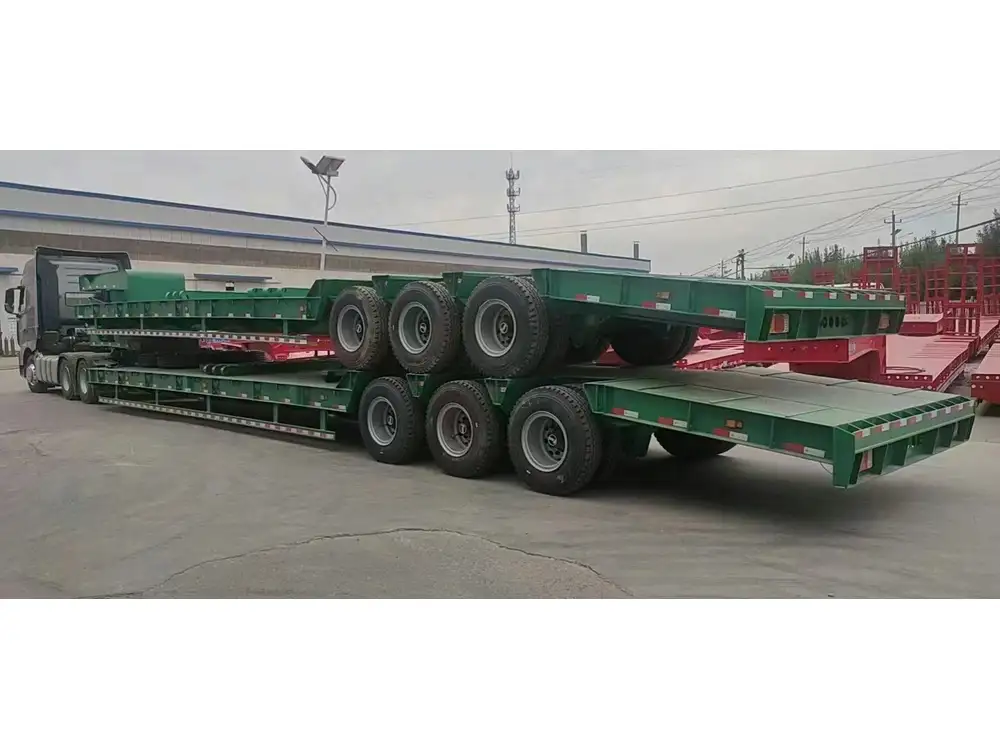When it comes to the logistics and transport industry, flatbed trailers are indispensable. They facilitate the movement of various oversized and heavy loads, from construction materials to machinery. One critical question arises frequently from truck operators, logistics managers, and businesses engaged in heavy hauling: How much weight can you put on a flatbed trailer? This article aims to dissect the complexity of this question, providing you with a thorough understanding of weight capacity considerations, regulations, and safety protocols.
The Basics of Flatbed Trailers
What is a Flatbed Trailer?
Flatbed trailers distinguish themselves through their open design, with no sides or roof, making them highly versatile for hauling irregularly shaped cargo. They come in various lengths, widths, and weight capacities, making it crucial to select the appropriate trailer based on the cargo specifications.

Types of Flatbed Trailers
| Type | Description | Common Uses |
|---|---|---|
| Standard Flatbed | A flat surface used for various goods, typically with a maximum capacity of 48,000 lbs. | General freight, machinery |
| Step Deck | Features a lower deck for increased height clearance, usually 10-12 inches lower than a standard. | Tall or oversized loads |
| Double Drop Deck | Has two drops—one at the front and one in the rear—ideal for heavy but tall loads. | Construction equipment |
| Extendable Flatbed | A trailer that can extend in length to accommodate oversized loads. | Long materials like lumber |
Key Factors Determining Weight Capacity
1. Trailers and Axle Configuration
The weight capacity of a flatbed trailer heavily relies on its construction and axle configuration. A common flatbed trailer may have a three-axle system, distributing the weight evenly, which helps comply with legal limits. The more axles present, the greater the weight capacity often becomes, given that specific bridge law regulations are met.

2. Material Strength
Flatbeds manufactured from high-strength steel or aluminum dramatically influence their weight-bearing capacity. Steel provides durability and can handle significant loads, while aluminum, being lighter, may limit overall weight but is effective for decreased fuel consumption.
3. Load Distribution
Even the most robust flatbed trailer can reach its critical breaking point if the load is distributed unevenly. Proper weight distribution is essential:
- Center of Gravity: Keeping the load’s center of gravity as low and centered as possible enhances stability.
- Securing Load: Utilizing appropriate tie-down techniques safeguards the cargo.
4. Regulatory Considerations
Weight capacities are often not just a matter of physical limits but also governed by legal regulations that vary by state and country. The Federal Bridge Formula is crucial here, which states specific weight limits based on the number of axles and the spacing between them.
A Quick Look at Federal Bridge Formula:
[ W = \frac{LN}{N-1} + 12N + 36 ]Where:
- (W) = maximum weight in pounds carried on a group of two or more axles
- (L) = distance in feet between the outer axles of any group of two or more axles
- (N) = number of axles in that group
It’s paramount to familiarize yourself with local regulations to avoid costly fines or penalties.

Maximum Weight Limits for Flatbed Trailers
Actual Load Limits
While the general maximum weight limit for a typical flatbed trailer stands at around 48,000 lbs, it’s essential to consider:
- State Regulations: Varying state laws can impose stricter limits.
- Weight Distribution: Improper weight distribution can lead to enforcing a lower capacity on specific trailers.
Comparison of Standard Maximum Capacities
| Trailer Type | Typical Weight Capacity (lbs) | Features |
|---|---|---|
| Standard Flatbed | 48,000 | Versatile, ideal for most cargo |
| Step Deck | 40,000 | Lower deck, suitable for tall loads |
| Double Drop Deck | 30,000-40,000 | Enhanced height clearance |
| Extendable Flatbed | 45,000 (may vary) | Extends to accommodate larger loads |

The Short and Long Hauls: Considerations
When planning your haul, consider whether you are looking at a short or long-distance journey. This can affect how much weight you can afford to load. Longer distances may impose more strain, necessitating a decrease in load weight to conserve trailer integrity and reduce tire wear.
Safety Considerations for Loading and Hauling
Loading and hauling isn’t just about knowing weight limits; it’s also about safety. To ensure for both your cargo and your transporters, consider the following guidelines:
1. Proper Securing Techniques
Using appropriate tie-downs is non-negotiable. The Securement Guide from the Federal Motor Carrier Safety Administration (FMCSA) underscores guidelines to ensure the cargo does not shift during transit:
- Straps and Chains: Utilize sufficient strength; based on the cargo weight.
- Tarps: Protect cargo from the elements, especially for weather-sensitive loads.

2. Regular Maintenance Checks
Ensure that the trailer is regularly inspected for:
- Brake Functionality: A malfunction could lead to the inability to stop, endangering drivers and other road users.
- Tire Integrity: Tires should have adequate tread and be inspected for any signs of wear and tear.
- Structural Integrity: Regular visual inspections can prevent unsafe loading conditions.
3. Training for Drivers
Equipping drivers with knowledge about weight distribution, cargo securing methods, and regulatory compliance creates a safer transport environment. Regularly updated training ensures that they remain knowledgeable about any changes in regulations.
How to Calculate Your Load

Weight Calculation Steps
When faced with the task of determining how much you can load on your trailer effectively, follow these steps:
- Know Your Trailer’s Capacity: Gather details about the specific trailer you will be using.
- Determine the Cargo Weight: Use a scale to weigh the cargo if possible.
- Factor in Vehicle Weight: Don’t forget to account for the truck’s weight. The total combined weight must not exceed the legal maximum.
- Calculate the Load Distribution: Ensuring even distribution can help you load more efficiently, allowing for maximum capacity without risking safety.
Example Calculation
If your flatbed trailer has a capacity of 48,000 lbs, your truck weighs 12,000 lbs, and the total allowable weight is 80,000 lbs, the calculation would look like this:
- Total Allowable Weight – Truck Weight = Available Trailer Weight
- 80,000 lbs – 12,000 lbs = 68,000 lbs
- Thus, you can load a maximum of 48,000 lbs, but you can load up to 68,000 lbs if the vehicle configuration allows.
Tools to Aid in Load Management
Utilizing software or apps for load management can help streamline the process. These tools can assist in:
- Calculating weight capacities
- Assessing load distributions
- Ensuring compliance with federal and state regulations

Conclusion: Mastering Flatbed Trailer Weight Limitations
Understanding how much weight you can put on a flatbed trailer is a multifaceted matter requiring a thorough grasp of vehicle specifications, regulatory frameworks, safety standards, and accurate weight calculations. With regulations varying across locations and with specific trailer characteristics adding complexity, it is imperative to approach flatbed towing with diligence and precision.
The knowledge you gain from this exploration not only helps in maximizing operational efficiency but also ensures that safety is maintained during the loading and transportation process, steering your business toward successful logistics management. It is our commitment to support the transportation industry by emphasizing best practices in flatbed trailer usage to promote both business growth and road safety.



